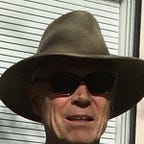Jack
This is a true story, and while it may mean nothing to the universe at large, I found it to be a curious connection. About an hour ago I was doing two things, if not simultaneously, at least seemingly so. One of the two things is the project, a collage with text, titled, “Jack,” which melds b&w photos from the Beat Generation, i.e., William Burroughs, Jack Kerouac, Neal Cassady. The collage contains my narrative vis-à-vis my own experiences with Beatniks, and later, hippies, and at this point in its construction, has only the rudiments of any mathematics in between the pictures. I’d been struggling with this piece: I had decided to emphasize the philosophy of this time period along with a few gurus, but thus far I was encountering a bridge-less, empty span from the whimsical music of the ‘60’s to any subset of mathematics
The other ‘thing’ I was doing amounted to my own education in the fairly new area known as Complexity Theory. It attempts to characterize computational complexity and provides criteria for its stated major challenge, namely, solving the question over whether decision problems in the NP class (decision problems with verifiable solutions in polynomial time, known as nondeterministic polynomial time problems) are all actually members of the P class (decision problems solvable with a Turing machine in polynomial time).
This would solve one of the Clay Institute’s seven Millennium questions, each worth $1,000,000 if solved. In 2020 someone said they had solved it, but it’s still being investigated.I thought I should read what I could about P vs. NP, so I went to YouTube where earlier I had learned how to make a temporary outside sink for grey water during our remod. If it could teach me the difference between pipe threads and hose threads, then P vs. NP should be not NP. I found a video from MIT and this one https://www.youtube.com/watch?v=YX40hbAHx3s It was fast-paced and not boring.
So here’s my moment of serendipity. I watched the whole video and found it instructive. With less than a minute left on the recording, the narrator began growing empathetic, and then the voice said that complexity theory was really a quest to simplify difficult-appearing problems and quoted two or three luminaries. He ended with: “One day I will find the right words and they will be simple.” And who said this? JACK KEROUAC!!! Somebody had made the exact same CONNECTION BETWEEN JACK BLEEDING KEROUAC AND COMPLEXITY THEORY!! Not possible. Two people on this planet made this comparison —
William of Occam: “never multiply entities beyond necessity.”
